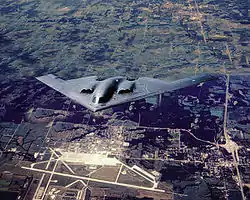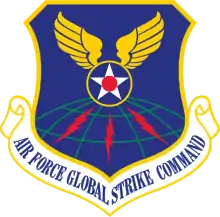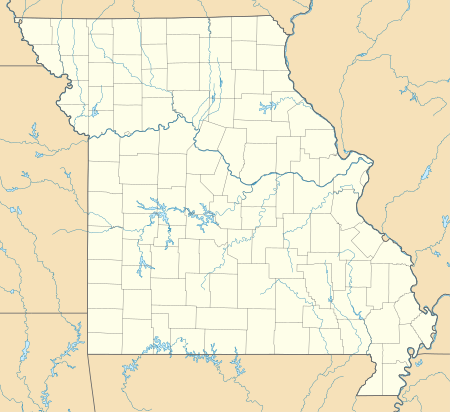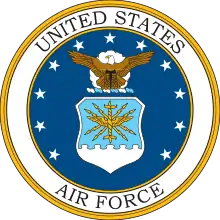Whiteman Air Force Base
Whiteman Air Force Base is a United States Air Force base located just south of Knob Noster, Missouri, United States. The base is the current home of the B-2 Spirit bomber.
| Whiteman Air Force Base | |||||||
|---|---|---|---|---|---|---|---|
| Near Knob Noster, Missouri in the United States of America | |||||||
 A B-2A Spirit from the 509th Bomb Wing flying over Whiteman AFB. | |||||||
 | |||||||
 Whiteman  Whiteman | |||||||
| Coordinates | 38°43′49″N 093°32′55″W | ||||||
| Type | US Air Force Base | ||||||
| Site information | |||||||
| Owner | Department of Defense | ||||||
| Operator | US Air Force | ||||||
| Controlled by | Air Force Global Strike Command (AFGSC) | ||||||
| Condition | Operational | ||||||
| Website | www.whiteman.af.mil | ||||||
| Site history | |||||||
| Built | 1942 (as Sedalia Glider Base) | ||||||
| In use | 1942 – present | ||||||
| Garrison information | |||||||
| Current commander | Colonel Jeffrey T. Schreiner | ||||||
| Garrison | 509th Bomb Wing (Host) | ||||||
| Airfield information | |||||||
| Identifiers | IATA: SZL, ICAO: KSZL, FAA LID: SZL, WMO: 724467 | ||||||
| Elevation | 265.4 metres (871 ft) AMSL | ||||||
| |||||||
| Source: Federal Aviation Administration[1] | |||||||
History
World War II
In 1942, the U.S. Army Air Corps selected the site of the present-day base to be the home of Sedalia Glider Base, a training base for WACO glider pilots. In May 1942, construction workers began building a railroad spur for the new air base in an area known to locals as the "Blue Flats" because of the color of the soil. The new railroad line was built by the Missouri Pacific Railroad. The base was officially opened on 6 August 1942. On 12 November 1942, the name was changed to Sedalia Army Air Field.[2]
After the end of World War II, operations at the airfield declined, and many of the buildings were abandoned. In December 1947, the base was put on inactive status.[3]
340th Bomb Wing
In August 1951, the base was renamed again, to Sedalia Air Force Base, as it was now part of the United States' newest military service branch, the US Air Force.[2]
In October 1952, the base was turned over to the 340th Bomb Wing. Improvements were made to the 1942 runway, as well as other base facilities, and Strategic Air Command (SAC) scheduled the base to receive squadrons flying the B-47 Stratojet and the KC-97 Stratofreighter. The first B-47 landed at the base in March 1954.[3]
On 3 December 1955, the base was renamed Whiteman Air Force Base in honor of 2nd Lt. George A. Whiteman, an Army Air Corps pilot who was killed during the Japanese attack on Pearl Harbor while attempting to take off from Bellows Field. Whiteman was born in Longwood, Missouri, and graduated from Smith-Cotton High School in Sedalia, less than 20 miles from the base that would bear his name.[2]
ICBM era
In 1963, Whiteman AFB transitioned from being a bomber base to a missile base. SAC activated the 351st Strategic Missile Wing at Whiteman on February 1. On September 1, the remnants of the 340th Bomb Wing were transferred to Bergstrom AFB in Texas.
The transition to missile base required a massive construction project. 867,000 cubic yards of earth and rock were excavated to make room for underground launch facilities and 15 launch control centers. 168,000 yards of concrete, 25,355 tons of reinforcing steel, and 15,120 tons of structural steel were used in the effort, and a vast underground intersite cable network was installed.
The 351st employed the LGM-30 Minuteman weapons system, an ICBM capable of hitting targets up to 4300 miles away. In the mid-1960s, the Minuteman I missiles were swapped out in favor of the Minuteman II, an ICBM with increased range and an improved guidance system.
In the 1980s, Whiteman AFB became the first missile base to field an all-female Minuteman missile crew, as well as the first male and female Minuteman crew.[2]
B-2 era
At the 1986 Reykjavik Summit between U.S. President Ronald Reagan and the new Soviet General Secretary Mikhail Gorbachev, the United States and the Soviet Union agreed to a drawdown of nuclear arms via two treaties: the INF Treaty and START I. This would lead to the eventual phase-out of the Minuteman II systems at Whiteman, and put the future of the base in question. On January 5, 1987, Ike Skelton, a Congressman representing Missouri's 4th district, announced that Whiteman AFB would be the home of the USAF's new Advanced Technology Bomber, which would eventually be called the B-2 Spirit.
On November 30, 1988, SAC announced that the 509th Bomb Wing would become the nation's first operational B-2 bomber unit. On December 17, 1993, Whiteman's first B-2 touched down on the runway.[4] 21 B-2s would eventually be produced, 20 of which are still operational. All 20 are based at Whiteman.[5]
Based units
Units marked GSU are Geographically Separate Units, which although based at Whiteman, are subordinate to a parent unit based at another location.
United States Air Force
|
Air Force Global Strike Command (AFGSC)
Air Combat Command (ACC)
Air Force Reserve Command (AFRC)
|
Air National Guard (ANG)
United States Army
United States NavyNavy Expeditionary Combat Command (NECC)
|
References
- "Airport Diagram – Whiteman AFB (KSZL)" (PDF). Federal Aviation Administration. 10 October 2019. Archived from the original (PDF) on 4 November 2019. Retrieved 30 November 2019.
- "Whiteman Air Force Base". 12 August 2010. Retrieved 30 March 2020.
- Larson, George A. (2018). Whiteman Air Force Base. Arcadia Publishing. p. 29. Retrieved 30 March 2020.
- Mailes, Yancy (16 December 2013). "The B-2 comes to Missouri". Air Force Glocal Strike Command. Retrieved 5 April 2020.
- Insinna, Valerie (29 April 2019). "Here's how B-2 bomber pilots pull off grueling 33-hour flights". Defense News. Retrieved 5 April 2020.
- Hunt, Heidi (15 March 2013). "Naval reservists train in America's heartland > > Display". Whiteman AFB. US Air Force. Retrieved 9 November 2019.
- "509th Operations Group". Whiteman Air Force Base. United States Air Force. Retrieved 31 March 2020.
- "509th Maintenance Group". Whiteman Air Force Base. United States Air Force. Retrieved 31 March 2020.
- "509th Medical Group". Air Force Medical Service. US Air Force. Retrieved 31 March 2020.
- "509th Mission Support Group". Whiteman Air Force Base. US Air Force. Retrieved 31 March 2020.
- Pine, Lt. Col. Louis (25 August 2017). "Evolution of airpower > Whiteman Air Force Base > Display". Whiteman AFB. US Air Force. Retrieved 30 April 2020.
- "Units". Whiteman Air Force Base. US Air Force. Retrieved 31 March 2020.
- "Units". 442d Fighter Wing. US Air Force. Retrieved 31 March 2020.
- "Units". 131st Bomb Wing. US Air Force. Retrieved 31 March 2020.
- Hunt, Heidi (15 March 2013). "Naval reservists train in America's heartland > > Display". Whiteman AFB. US Air Force. Retrieved 9 November 2019.

